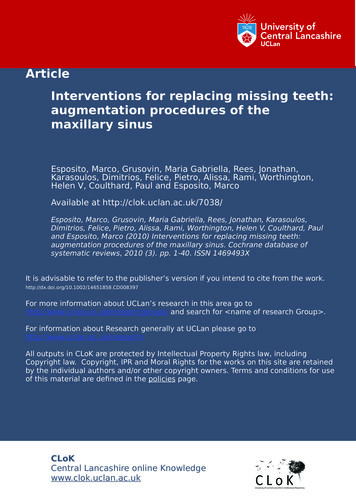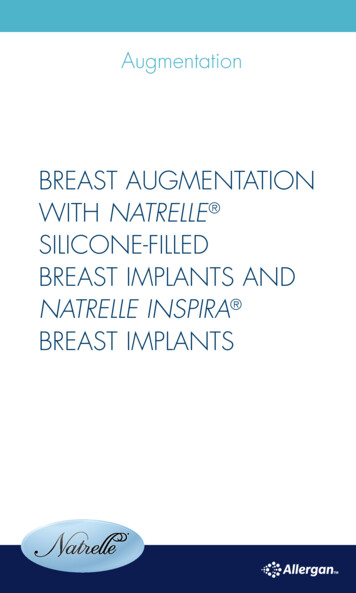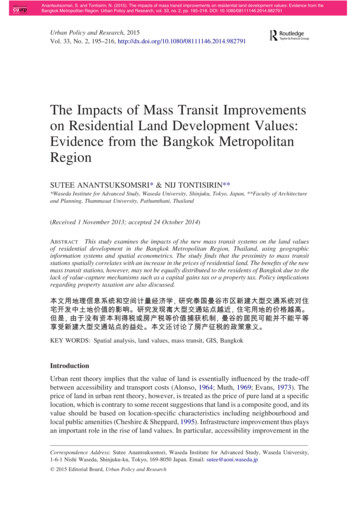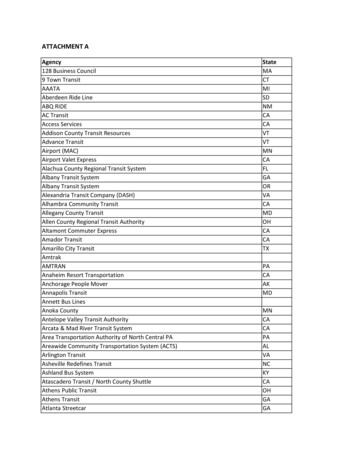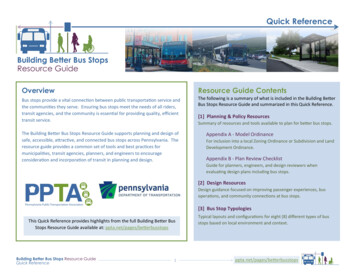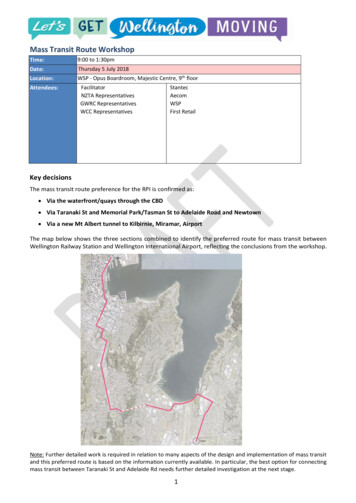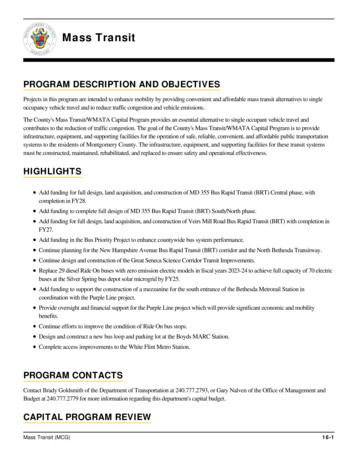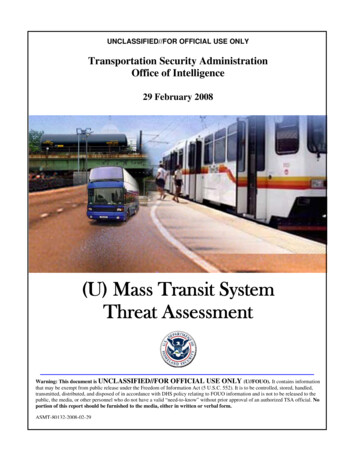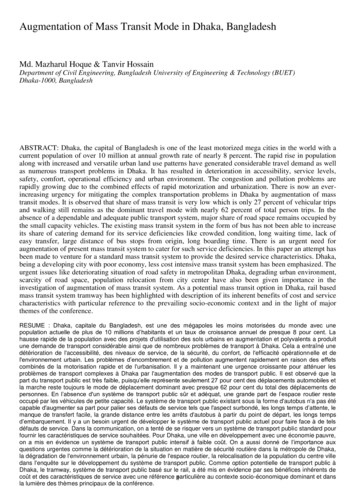
Transcription
Augmentation of Mass Transit Mode in Dhaka, BangladeshMd. Mazharul Hoque & Tanvir HossainDepartment of Civil Engineering, Bangladesh University of Engineering & Technology (BUET)Dhaka-1000, BangladeshABSTRACT: Dhaka, the capital of Bangladesh is one of the least motorized mega cities in the world with acurrent population of over 10 million at annual growth rate of nearly 8 percent. The rapid rise in populationalong with increased and versatile urban land use patterns have generated considerable travel demand as wellas numerous transport problems in Dhaka. It has resulted in deterioration in accessibility, service levels,safety, comfort, operational efficiency and urban environment. The congestion and pollution problems arerapidly growing due to the combined effects of rapid motorization and urbanization. There is now an everincreasing urgency for mitigating the complex transportation problems in Dhaka by augmentation of masstransit modes. It is observed that share of mass transit is very low which is only 27 percent of vehicular tripsand walking still remains as the dominant travel mode with nearly 62 percent of total person trips. In theabsence of a dependable and adequate public transport system, major share of road space remains occupied bythe small capacity vehicles. The existing mass transit system in the form of bus has not been able to increaseits share of catering demand for its service deficiencies like crowded condition, long waiting time, lack ofeasy transfer, large distance of bus stops from origin, long boarding time. There is an urgent need foraugmentation of present mass transit system to cater for such service deficiencies. In this paper an attempt hasbeen made to venture for a standard mass transit system to provide the desired service characteristics. Dhaka,being a developing city with poor economy, less cost intensive mass transit system has been emphasized. Theurgent issues like deteriorating situation of road safety in metropolitan Dhaka, degrading urban environment,scarcity of road space, population relocation from city center have also been given importance in theinvestigation of augmentation of mass transit system. As a potential mass transit option in Dhaka, rail basedmass transit system tramway has been highlighted with description of its inherent benefits of cost and servicecharacteristics with particular reference to the prevailing socio-economic context and in the light of majorthemes of the conference.RESUME : Dhaka, capitale du Bangladesh, est une des mégapoles les moins motorisées du monde avec unepopulation actuelle de plus de 10 millions d’habitants et un taux de croissance annuel de presque 8 pour cent. Lahausse rapide de la population avec des projets d'utilisation des sols urbains en augmentation et polyvalents a produitune demande de transport considérable ainsi que de nombreux problèmes de transport à Dhaka. Cela a entraîné unedétérioration de l'accessibilité, des niveaux de service, de la sécurité, du confort, de l'efficacité opérationnelle et del'environnement urbain. Les problèmes d’encombrement et de pollution augmentent rapidement en raison des effetscombinés de la motorisation rapide et de l'urbanisation. Il y a maintenant une urgence croissante pour atténuer lesproblèmes de transport complexes à Dhaka par l'augmentation des modes de transport public. Il est observé que lapart du transport public est très faible, puisqu’elle représente seulement 27 pour cent des déplacements automobiles etla marche reste toujours le mode de déplacement dominant avec presque 62 pour cent du total des déplacements depersonnes. En l’absence d'un système de transport public sûr et adéquat, une grande part de l’espace routier resteoccupé par les véhicules de petite capacité. Le système de transport public existant sous la forme d'autobus n'a pas étécapable d'augmenter sa part pour palier ses défauts de service tels que l'aspect surbondé, les longs temps d’attente, lemanque de transfert facile, la grande distance entre les arrêts d'autobus à partir du point de départ, les longs tempsd’embarquement. Il y a un besoin urgent de développer le système de transport public actuel pour faire face à de telsdéfauts de service. Dans la communication, on a tenté de se risquer vers un système de transport public standard pourfournir les caractéristiques de service souhaitées. Pour Dhaka, une ville en développement avec une économie pauvre,on a mis en évidence un système de transport public intensif à faible coût. On a aussi donné de l’importance auxquestions urgentes comme la détérioration de la situation en matière de sécurité routière dans la métropole de Dhaka,la dégradation de l'environnement urbain, la pénurie de l'espace routier, la relocalisation de la population du centre villedans l'enquête sur le développement du système de transport public. Comme option potentielle de transport public àDhaka, le tramway, système de transport public basé sur le rail, a été mis en évidence par ses bénéfices inhérents decoût et des caractéristiques de service avec une référence particulièreau contexte socio-économique dominant et dans1la lumière des thèmes principaux de la conférence.
Poverty incidence – 54 percent (highest in Asiancities). Dhaka’s contribution to country’s GDP – nearly 15percent. Road network–3000km (with only 450km primaryand secondary/ collector roads). Road vehicles nearly 250,000 with huge number ofrickshaws (500,000). Trip percent catered by Mass Transport – 10percent. Cost of congestion and accidents – Tk. 3,000 crore(US 520 million per annum). Air pollution and noise level 4 (in 1-10 scale). Urban road accident fatalities – 400 (reported perannum). Percent road fatalities who are pedestrians -60percent. Non-existent of qualified traffic engineeringprofessionals.The combined effects of enormous increase of bothmotorised and non-motorised vehicles, large scaleurbanisation, influx of huge number of people fromrural area, absence of adequate, organised,dependable mass transit system, indisciplined andpoorly managed traffic control system inconjunction of with inherent deficiency in planning,designing and maintenance of roadway and streetsystems created a hazardous travel environment inthe metropolitan area.1. INTRODUCTIONIt has become increasingly clear that adequate andefficient mass transit service plays an important rolein combating the ever-worsening problems of trafficcongestion and improving safety within urban areas.This paper discusses issues and needs foraugmentation of mass transit modes in metropolitanDhaka and forms part of broader study (Hossain,2002) on introduction of tramway as a mass transitmode in Dhaka. Dhaka, the capital of Bangladesh isone of the least motorized mega cities in the worldwith a current population of over 10 million atannual growth rate of nearly 8 percent. The rapidrise in population along with increased and versatileurban land use patterns have generated considerabletravel demand as well as numerous transportproblems in Dhaka. It has resulted in deterioration inaccessibility, service levels, safety, comfort,operational efficiency and urban environment. Rapidmotorization has been followed by rapidurbanization. From the modal split information it hasbeen observed that trends in change of passengertrips in percentage is towards motorized mode fromnon-motorized modes in Dhaka. But this rapidgrowth of motorization with urbanization bas beenaccomplished in an inefficient and uncontrolled way.The present passenger transport scenario ofmetropolitan Dhaka shows that the existing masstransport facilities are not sufficient to keep pacewith growing population. Growth rates for lowoccupancy vehicles are higher than those of highoccupancy vehicles, such as buses and minibuses.As a result major share of road space remainsoccupied by the small capacity vehicles. Thistransport situation consequently has increased trafficcongestion, travel delay and accident. The paperargues that the Augmentation of present mass transitsystem has therefore become a central issue forsolving urban transport problem in Dhakametropolitan area.3. DHAKA’S TRAVEL MODAL SPLIT AND ITSIMPACT3.1 Present Modal SplitThe latest surveys of persons movement inmetropolitan Dhaka under the Dhaka UrbanTransport Project showed walking as thepredominant mode with a share of 62 percent oftotal person trips. This is followed by rickshaw(13.3%), bus (10.3%), auto rickshaw (5.8%), and car(4%). In consideration of person trips by vehicle,rickshaw takes the highest share, accounting for 35percent followed by bus (21%), auto rickshaw(15.2%), car (10.5%) (JBIC, 2000).2. BRIEF DETAILS OF METROPOLITANDHAKADhaka, the capital of Bangladesh, is one of the leastmotorised mega cities in the world. Between 1960and 2000 Dhaka grew rapidly from 1 millionpopulation to 10 millions. The following are thebrief details of Dhaka: Population –10 million with a growth rate of 8percent per annum. Dhaka as percent of Bangladesh – 8 percent, andaccounts for 33 percent of total urban population3.2 Trends in Modal SplitIt has been observed that rickshaw and walk tripshave declined in the form of percentage of persontrips in recent years (Hossain, 2002). Rickshaw'scontribution has reduced from 47.8 percent (1992) to35 percent (1999) of person trips by vehicle. Walktrips have lessened from 64.9 percent (1992) to 62percent (1999) of total person trips. But auto2
rickshaw trips and trips by car have increased. Inpercentage of person trips by vehicle, share of autorickshaw has increased from 3.3 percent (1992) to15.2 percent (1999). Bus takes almost the sameshare of person trips in percentage in between thistime period. So trend in change of modal split istowards motorized auto rickshaw from nonmotorized rickshaw and walking. Absence ofefficient mass transit is responsible for high share ofpassenger trips taken, by auto rickshaw. It is causingcongestion and deterioration of environment.4. MASS TRANSIT SYSTEM IN DHAKA ANDITS IMPROVEMENT STRATEGIESThe mass transport facility in Dhaka is composed ofindividual private sector operators with almostcomplete dependency on small capacity minibuses,the exception being some standard single deckersand double deckers operating on a minority ofroutes.4.1 Bus Transportation in DhakaIt is observed that bus traffic in Dhaka is on a levelof baby compared with other cities (DSMConsultants, 2000). Colombo which has apopulation of 4 .6 million, has over 7600 buses andminibuses while Dhaka with 10 million has around2000). Today's bus operation in Dhaka ischaracterized with .the existence of 750 individualbus owners. In developing countries the commoneffort is price control in public transport. Forcing theticket prices to such that traveling is possible for thepoor, makes the private operations unprofitable,unless driving overcrowded buses. So the quality oftransport stays poor and not appreciated by thetravelers (DSM Consultants, 2000). This is the truescenario of bus transport in Dhaka. Investment is notincreasing in enlarging bus fleet in Dhaka for theprobability of unprofitable business.3.3 Traffic Induced PollutionAir quality in Dhaka has already reached at an,alarming stage in many aspects according to thedepartment of environment (DOE) and othersources. Average hourly concentration of Carbonmono-oxide (CO) and particulate matter (PM),concentration of 1ead in blood among the residentsof Dhaka have exceeded the danger level. In theroads of Dhaka city the concentration of oxides ofnitrogen (NOx), oxides of sulfur (SOx), carbonmono oxide (CO) and suspended particulate matter(SPM) are 500, 1200, 7500 and 2500 µgm per cubicmeter respectively which far exceeds the acceptablelimit set by WHO. Bus has contributed significantlyto increase concentration of NO, PM, SO2. Autorickshaws are the major contributors to CO, HSemission (31%) followed by cars (31%) andmotorcycle (24%)(JBIC ,2000). These three modesare also responsible for high concentration of lead inair in Dhaka.4.2 Factors of Poor Service Quality Transport inDhakaThe present mass transit mode in the form of buspassenger transport has not been able to be popularand grow its share of catering demand. Japan Bankfor International Cooperation(JBIC) data sourcesreveal that service deficiencies indicated by users ofrickshaw are crowded condition of bus, long waitingtime, lack of easy transfer, bus stops are not nearfrom origin, long boarding time. Service deficienciesindicated by bus users are discomfort and congestion(Figures 1 & 2 are typical examples). A survey onpedestrians detected service deficiencies in the formof long waiting time, long travel time, lack ofcomfort, lack of stoppages etc.3.4 Urban Road Safety ProblemsWith the dominance of walk mode in Dhaka, currentstatistics revealed a deteriorating situation of roadsafety in the case of pedestrians in metropolitanDhaka. Pedestrians as a proportion of road accidentdeaths increased from 43 percent in 1986-87 to 67percent in 1991-92. In most recent years (19961998) the number of pedestrian causalities hasincreased markedly, from 433 in 1996 to 588in1998, an increase of about 29 percent. With fatalaccidents 70 percent was ‘pedestrian-motorizedvehicle’ collisions. With continuous growth in urbanpopulation in Dhaka particularly the urban poor, therisk to pedestrian safety is expected to be worsenedin the future which demands comprehensive safetymeasures be initiated. Further details about roadsafety problems could be seen in Hoque andAlam(2002).3
capacity and thus relieving traffic congestion are thesignificant strategies. There are several options inmass transit facility including Bus way; Tram, LRT(Light Rail Transit) and Metros. Their characteristicsare briefly reviewed: Bus way: Bus ways are controlled accessfacilities dedicated for bus service separated fromgeneral traffic, often with grade-separated rights ofway. These are generally segregated sections ofroadway within major corridors with horizontalprotection from other traffic, and priority overother traffic at junctions, which are generallysignalized (Martinelli, 1996). Tram: Tram is an urban rail based systemoperating along streets in mixed traffic. It is a basicform of LRT that has limited rights of way, sharingroad space for much of their route length withordinary traffic. Tramways provide a slow, lowcapacity but cheap form of transit. The vehicles runon roads flush with the roadway and consist oftrams that can carry about l00 to 200 sitting andstanding passengers. Trams operating in singleunits in mixed traffic with headways of one minuteare able to carry 6000 passengers per hour pertrack, journey speed is about 12 km/hr. Thiscapacity can be boosted to 12000 by providinglarger trams and can be further increased to 15000if the vehicles operate on exclusive right of way.Trams and streetcars typically have high floors andsteps to street level (like buses). LRT: LRT systems have segregated but notnecessarily grade separated right of way. Thesesystems usually employs vehicles and trackconstruction that are less substantial than a fullmetro system. Speeds, capacity and overallperformance are generally lower than for fullygrade-separated rapid transit. It is economicallyjustified in urban area where conventional railrapid transit may not be feasible .LRT has arelatively higher frequency of stops whencompared to rail rapid transit. It has high platformssimilar to a metro. Some systems have at gradecrossings (with or without traffic signal priority)and low-level platforms. LRT trains may be madeup to two or three cars, with a total capacity of upto 750 passengers (250 passengers per car). Metros: A metro is fully segregated, usuallyelevated or under ground, is often referred to as anunderground railway (Subway), but can, in fact, beany grade- separated urban railway. The track andelectric vehicles are similar to suburban railwaysthough with closer station spacing. Trains mayhave 6-8 cars, with a total capacity of up to 3000passengers, in some cases trains are operated overan extensive network. It has high capacity at anextremely high cost.Figure 1. City Street Scene in DhakaFigure 2. Bus Riding in Metropolitan Dhaka.4.3 Strategies of Mass Transport Improvement inDhakaIt is expected that Dhaka will have to accommodatean additional two million people within Dhaka CityCorporation and some five million within themetropolitan area within 15 years (JBIC, 2000). Thepopulation and its trend in Dhaka is indicating thepossible bus fleet need of 10-15000 instead ofcurrent 2000 which would take several years toachieve. Moreover, within large metropolitan areaslike Dhaka with a population of over 10 million, it isunsuitable and uneconomical to operate only oneexclusive public transportation system (Ahsan,1990). From this viewpoint introduction of improvedmass transit is important. Development of bus waysand bus priority facilities, development of LRT areincluded in mid to long-term measures of urbantransportation improvement measures in Dhaka.Recently steps have been taken for findingpossibility of monorail (overhead bridge system oftransit) and underground railway.But both the ideas seem to be unrealistic in contextof Dhaka. Metro is a very high capital and operatingcost system. Besides, metro system is appropriate forcity income which is not low, typically at least 1800US dollars per person (ADB, 2001) which mayrequire a long time to achieve in the context ofDhaka. In the context of low income developingcountry, bus ways, light rail transits seem to berealistic solutions of urban transportation problem ofmetropolitan Dhaka.5. MASS TRANSPORT OPTIONS5.1 Various Mass Transit OptionsRevitalization of public transport is a core issue inthe context of rapid motorization. Improving qualityof public transport, increasing public transport4
5.2 Tramway as a Mass Transit Optionidle engine combustion cost for tram. Tram brakingsystem does not produce injurious elements.Moreover any transport system with electricpropulsion does have the key advantage that themain source of generation of pollution can beconcentrated for safe treatment and dispersion. Comfort: Tram rails offer a flat surface, muchsmoother than a road surface. The curves of a tramtrack are carefully calculated to 1ead the tramgently into corners without sudden changes indirection. All these aspects make standingcomfortable in tram. Large numbers of standingpassengers are permitted in safety which reducesqueues during rush hour. Physical accessibility: Tram is easily accessible.The rails will guide the vehicle accurately intoplace .It stops at a certain place; a steerable vehiclecan’t do this. Modern low floor trams offer levelloading with no significant gap. This means thatonly a small increase in kerb stone height issufficient to give level access from a normalpavement. With a steerable vehicle, this wouldpose a danger, as a gap would have been leftbetween the vehicle and kerb to avoid scraping thedoorstep. With a tram, the rails will always guidethe vehicle accurately into place, ensuring the gapis minimal. This gives level, safe, easy access forwomen, children, elderly people. Safety: A tram cannot leave the track and there isno risk of colliding with vehicles on other parts ofthe road or with track-side objects or pedestrians.The path taken by a tram is clearly marked and thevehicle never deviates from that path. Thiscontributes greatly to safety for other road users. Occupy little space: Segregated or 'reserved'tracks need to be only slightly wider than the trambody -for the proposed Bath trams about 8ft wideshould suffice. They can run along disused railwaylines, open sites, specially designated streets or thecentres of dual carriageway. Enhance outward growth of city: A tramwayrepresents a long-term investment in theinfrastructure of an area, it is the perceivedpermanence and long-term reliability of this, whichenhances the value of land and property, andencourages regeneration. Businesses and homescan be relocated to take advantage of the tramroutes in the safe knowledge that they will not findthemselves at the mercy of a route planners whim.Tram is a slow, low capacity but cheap form of masstransit and it is a basic form of light rail transit.(Gardner Rutter & Kuhn 1994). Tramway has beenfound to be the cheapest in the systems of light railtransit in terms of total cost per passenger km.Public transport based on tracks like tramway hasmany advantages over other forms which includethe following(TRAMS For BATH Group, 2001): Low operating cost: At a particular level ofpassenger loading the tram becomes cheaper thanbus way. As passenger loading increases, a busservice will find, it needs progressively greaterinvestment in vehicles; running costs will alsoincrease proportionally. The gains due to'economies of scale' are slight. The bus finds aneconomical operating point at a relatively high fareand fewer passenger journeys, whereas the tram ismost economical when carrying large numbers ofpassenger journeys at a cheap fare. Fare and tendency of attraction of flexibledemand: As tramway is a low running cost highcapital-cost business; the major financial outgoingsare fixed debt servicing and repayment costs andmuch more competitive cost can be offered.Tramways are much less susceptible to therunning-cost penalty, which would discourage abus service (where overall expenditure was morenearly proportional to passengers carried) fromtrying to carry larger numbers of passengers atlower fares. In practice, tram fares are almostalways 1ower than the equivalent bus fares often50% or even less. This means that the bus carriesmainly passengers from the 'inflexible' demandgroup, whereas tram will capture passengers with amore "flexible” demand -for instance car owners. Increase of frequency: The running cost of a tramis less than a comparable bus, so frequent servicescan be run at times when a bus service would becut-back as uneconomical. Trams accelerate moresmoothly permitting greater acceleration rateswhich reduce the time between stops. All theseaspects of tram enable increased frequency. Capacity: For meeting increased travel demand,the carrying capacity of a single unit of tram can beincreased by attaching a trailer (or several). This ischeap and can easily be detached when it is notneeded, economizing in power and wear-and tear.A powered trailer or a double - decked vehicle canalso be effective. Environment Friendly Mass Transit: Electrictram/LRT is likely to be developed in cities whereenvironmental issues are uppermost and there is aperceived need to attract car users for anenvironmentally acceptable component of apackage to create a 'livable' city (ADB, 2001).Electric tram is environment friendly. There is no6. INTRODUCTION OF TRAMWAY IN DHAKA6.1 The ContextBangladesh with its resourcesignificant urban poor is inaugmentation of mass transit todemand specially in capital city5constraints andacute need ofcater for futureDhaka. Replogle
argues that income plays a significant roleinfluencing transportation choices people have.People with low-income face extremely limitedtransport choices. Two thirds of the poorest of thepoor in the world live in India, Bangladesh, Pakistanand China. It is critical to choose mass transit optionwhich will meet urgent issues of increased mobility,road accidents, environmental protection, and abilityof people to pay for travel. Light rail Transit hasbeen found to be the potential choice for cateringfuture travel demand in Dhaka. Development ofLRT is included in mid to long term measures ofurban transportation improvement measures inDhaka. Tramway is a basic type of LRT. It is alsothe cheapest in the systems of light rail transit whichis a positive element in the prevailing socioeconomic context of Dhaka city. Versatile urbanland use patterns in Dhaka city also demandtramway.Public transport based on tracks like tramway hasmany advantages over other forms. And theseadvantages are congruent with the service qualitydesired by trip makers of Dhaka particularly theshare of trips (Rickshaws, auto-rickshaws) that isrequired to be shifted to reduce congestion and airpollution. Urgent issues like road safety forpedestrians, deteriorating environment of Dhaka,scarcity of road space, population relocation demandrail based form of mass transit rather than road basedbus transit.permitted in safety, which reduces queues duringrush hour. Tram is easily accessible. Easy physicalaccessibility and inside comfort is a goodindication of attracting the flexible demand oftransport like rickshaw users, auto rickshaw users,pedestrians in Dhaka.6.3 Other Urgent IssuesIn the light of severe urban road accident problem,environment degradation and scarcity of road thefollowing considerations are significant in thecontext of Dhaka. A mass transit mode like tramway which cannotleave the track, is safe as there is no risk ofcolliding with pedestrians, vehicles on other partsof the road or with track-side objects. The pathtaken by a tram is clearly marked and the vehiclenever deviates from that path; this contributesgreatly to safety for other road users. Electric tram/LRT is likely to be developed incities where environmental issues are uppermosteven when bus transit and bus ways are morefeasible. As tramway occupies little space, it will beadvantageous to introduce where there is scarcityof road space. Tramway with its perceived permanence and longterm reliability is potential for playing key role inintensification of land use in sub-urban areasoutside the CBD, peripheral development.6.2 Benefits of Tramway in Context of DhakaTo meet the mobility needs in metropolitan Dhaka infuture the following points related to rail basedtramway are significant: Tramways are much less susceptible to therunning-cost penalty, which would encouragecarrying larger numbers of passengers at lowerfares. High frequency is permissible by rail based urbantransport tramway in the context of economies ofscale. Tram permits low operating cost to justifyincreased no. of round trips, easy acceleration anddeceleration to increase frequency of mass transit. Trams accelerate more smoothly permittinggreater accelerator rates, which reduce the timebetween stops. This is why tram can give frequentstops. Multiple stops will give access to morepeople and ease congestion. Pedestrians and nonmotorized rickshaw users desire frequent stops. Rail based mass transit has the advantage ofproviding comfort to the standing passengers as itruns on fixed track. In Dhaka. a standard level ofcomfort is desired by users of other mode(rickshaw users). Tram maintains that standard.Large numbers of standing passengers are6.4 Detailed StudyIn this paper an attempt has been made to present theservice characteristics of tramway that are ideal formeeting the travel attributes of trip makers of Dhaka.For the introduction of tramway more detailed studyis required. Feasibility and viability studies shouldbe carried out giving emphasis on urban dwellers’characteristics, land use patterns, road userperceptions, economic aspects of construction,traffic capacity, route selection and technicalcharacteristics.7. CONCLUDING REMARKSAugmentation of mass transit system is an urgentnecessity to ensure mobility need, road safety, andlivable urban environment for Dhaka city in future.Rail based rather than road based mass transitsystem seems to be more appropriate with desiredservice quality of trip makers of Dhaka. The urgentissues like prevailing socio-economic context, thedeteriorating environment of Dhaka, serious urbanroad accident situation, scarcity of road space,6
population relocation, and future adaptability havebeen stressed for the introduction of a dependablemass transit system. Rail based tramways, withdescription of its inherent cost and servicecharacteristics have been highlighted as a potentialoption for improvements of existing public transportsystem. Detailed study for its introduction has beensuggested giving due emphasis on urban dwellers’characteristics, land user patterns, economic aspectsof construction, traffic capacity, route selection andtechnical characteristics.Asian Institute of Technology, Bangkok and MonashUniversity, Melbourne respectively. Dr. Hoque’sPhD research encompasses studies on accidents byroad hierarchy and their long-term changes. While inMelbourne, he worked as a safety consultant/ analystat the Victoria Road Traffic Authority, the SateTransport Authority and the Royal Automobile Clubof Victoria (RACV) Ltd. His interests cover a rangeof traffic and transport areas and he authored manypapers internationally in the road safety area es. Professor Hoque played apioneering role in road traffic safety research inBangladesh, Australia and Thailand and was amember of International Steering Committee forConference on Asian Road safety in 1993. In 1994he was an invited faculty at the Indian Institute ofTechnology, New Delhi. During 1996-1997Professor Hoque spent his Sabbatical leave at theTransportation Research Group, Department of Civiland Environmental Engineering, University ofSouthampton, UK under the CommonwealthFellowship program for doing further research onroad safety audit in developing countries. He was amember of the International Steering Committee forthe ADB/UN-ESCAP initiated regional road safetyproject. Professor Hoque was also in the NationalSteering and Organising Committees for the ninthInternational Conference on Safe Communities(SafeComm-9) held at Dhaka in 2000 and was thecountry contact person for the tenth REAAAconference and PIARC. He is actively involved innumerous consultancy/advisory projects in the areasof transportation planning, traffic engineering &management, and road safety as well as in thedevelopment of urban transport policies.Mr. Tanvir Hossain has graduated from theBangladesh University of Engineering &Technology (BU
easy transfer, large distance of bus stops from origin, long boarding time. There is an urgent need for augmentation of present mass transit system to cater for such service deficiencies. In this paper an attempt has been made to venture for a standard mass transit system to provide the desired service characteristics. Dhaka,
